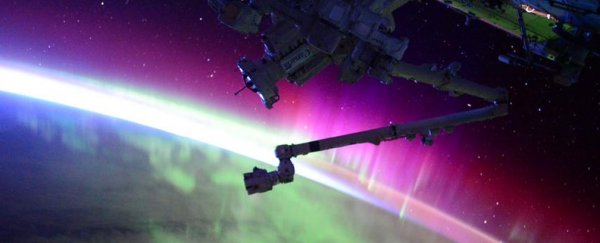Day 141. The chapter of a day ends as it began. #Aurora on a sunrise. Good night from @space_station! #YearInSpacehttps://t.co/hZBMs9q0CS
— Scott Kelly (@StationCDRKelly) August 15, 2015
The cosmic light shows put on by the Northern and Southern Lights (Aurora Borealis and Aurora Australis) are a beautiful thing to watch from Earth, and from space, they look just as mind-blowing.
This over-too-soon video shot from the International Space Station (ISS) shows what it looks like to fly over the Aurora Borealis as the sun comes up.
Captured by NASA astronaut (and prolific tweeter) Scott Kelly, the ravishing time-lapse footage shows the Northern Lights rippling like a liquid in the reaches of Earth's upper atmosphere. The light show slowly turns from a bright green into a darker violet as the gleaming dawn emerges from behind.
Signing off at the end of his 141st day aboard the ISS, Kelly shared the video by tweeting, "Day 141. The chapter of a day ends as it began. #Aurora on a sunrise. Good night from @space_station! #YearInSpace".
Alongside Russian cosmonaut Mikhail Kornienko, Kelly is approaching the halfway point of a record-breaking one-year-mission aboard the ISS, designed to better understand how long-term space missions and prolonged exposure to zero-gravity environments affect the human body.
While there are undeniably health risks associated with long periods of time spent outside Earth's protective atmosphere, there are clearly perks too, with Kelly's time-lapse video just being the latest example from his remarkable Twitter feed of the beautiful visions the ISS affords its occupants.
(Life aboard the ISS also provides some pretty unique gardening opportunities: the much-hyped space lettuce consumed by astronauts on the station recently was planted by Kelly.)
Aurorae like the Northern and Southern Lights are caused when charged solar particles collide with gases in our planet's atmosphere, creating intense, colourful displays. Depending on the gases involved in the interaction, we see different colours: green means oxygen, red is high-altitude oxygen (at least 320 km above the surface), and blue and purple hues are nitrogen.
